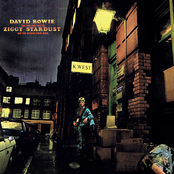The Rise and Fall of Ziggy Stardust and the Spiders From Mars

Biography
The Rise and Fall of Ziggy Stardust and the Spiders from Mars is a 1972 concept album by English rock musician David Bowie. It peaked at number five in the United Kingdom and number 75 in the United States on the Billboard Music Charts. A concert film of the same name directed by D.A. Pennebaker was released in 1973. Upon its release on 6 June 1972, Ziggy Stardust reached number five in the UK and number seventy-five in the US. The album was eventually certified platinum and gold in the UK and...
The Rise and Fall of Ziggy Stardust and the Spiders from Mars is a 1972 concept album by English rock musician David Bowie. It peaked at number five in the United Kingdom and number 75 in the United States on the Billboard Music Charts. A concert film of the same name directed by D.A. Pennebaker was released in 1973. Upon its release on 6 June 1972, Ziggy Stardust reached number five in the UK and number seventy-five in the US. The album was eventually certified platinum and gold in the UK and US respectively. The only single from the record, "Starman", charted at number ten in the UK while peaking at the sixty-fifth spot in the US. In 1997, Ziggy Stardust was named the 20th greatest album of all time in a Music of the Millennium poll conducted in the United Kingdom by HMV Group, Channel 4, The Guardian and Classic FM. In 1998, Q magazine readers placed it at number 24 and Virgin All-time Top 1000 Albums ranked it at number 11, while in 2003 the TV network VH1 placed it at number 48. It was named the 35th best album ever made by Rolling Stone on their list of the 500 Greatest Albums of All Time. In 2000 Q placed it at number 25 in its list of the 100 Greatest British Albums Ever. In 2004 it was placed at number 81 in Pitchfork Media's Top 100 Albums of the 1970s. In his 1995 book, "The Alternative Music Almanac," Alan Cross placed the album in the #3 spot on the list of '10 Classic Alternative Albums'. In 2006, the album was chosen by TIME magazine as one of the 100 best albums of all time. In 2005, Seu Jorge did a cover album of 14 Bowie songs, many of them from Ziggy Stardust, as a soundtrack for the movie The Life Aquatic with Steve Zissou called The Life Aquatic Studio Sessions. The translation into Portuguese is not always exact, as Seu Jorge maintains the melodies and styles, but often varies the lyrics. Musician Saul Williams named his 2007, Trent Reznor produced album The Inevitable Rise and Liberation of NiggyTardust!, clearly in a nod to Bowies album. Bowie claimed that the name came from a tailor's shop in London called Ziggy's. Bowie later told Rolling Stone it was "one of the few Christian names I could find beginning with the letter 'Z'." "Stardust" comes from one of Bowie's labelmates, a country singer named Norman Carl Odam, The Legendary Stardust Cowboy. Bowie covered a Legendary Stardust Cowboy song, "I Took a Trip (On a Gemini Spaceship)" thirty years later on Heathen. The Ziggy Stardust sessions began just a few weeks after Hunky Dory was released. The first song recorded for the album, the cover "It Ain't Easy," was recorded in September 1971. The first session in November produced "Hang on to Yourself," "Ziggy Stardust," "Rock 'n' Roll Star" (later shortened to "Star"), "Moonage Daydream," "Soul Love," "Lady Stardust," and "Five Years." Also recorded during the November Ziggy Sessions were two more cover songs intended for the as-yet untitled album. They were Chuck Berry's "Around and Around" (re-titled "Round and Round") and Jacques Brel's "Amsterdam" (re-titled "Port of Amsterdam"). A re-recording of "Holy Holy" (first recorded in 1970 and released as a single, to poor sales, in January 1971) was initially slated for Ziggy, but was dropped in favour of "Rock 'n' Roll Suicide." "Round and Round" was replaced by "Starman" and "It Ain't Easy" replaced "Amsterdam" on the album's final running order. All three were eventually released as b-sides. "Velvet Goldmine," first recorded during the Hunky Dory sessions, was also intended for Ziggy, but was replaced by "Suffragette City." RCA released it in 1975 as the b-side to the UK re-release of "Space Oddity" after having it remixed and mastered without Bowie's approval. After recording some of the new songs for Sounds of the 70s with Bob Harris (which appear on Bowie at the Beeb) as the newly-dubbed Spiders from Mars in January-February 1972, the band returned to Trident. They recorded "Starman," "Suffragette City," and "Rock 'n' Roll Suicide" by the end of the month. "Starman," released as a single in April (and not intended for the final album at first), has never appeared in its original "loud" mix on CD. It differs somewhat in that it "features a subdued 'morse code' section between the verse and the chorus" compared to the original released in 1972. "Starman"'s b-side, "Suffragette City," was mastered for the album with a three-note coda leading in from "Ziggy Stardust" to make the songs sound linked. They were never played as such by Bowie in concert. Recorded and released during the ensuing Ziggy tour were two other songs. The first, "John, I'm Only Dancing," was recorded at Trident in late June and released (in the UK only) in September. "The Jean Genie," recorded at RCA Studios in New York in early October at the start of the American tour, was released in the U.S. in November. The song was remixed for Aladdin Sane. Rock keyboardist Rick Wakeman was given the opportunity to play keyboards on the album but Rick opted to join the progressive rock group Yes instead. The album was intended by Bowie to serve as the soundtrack and musical basis for a stage show and/or television production telling the story of Ziggy Stardust. As well as the songs on the album, Bowie also intended songs such as "All the Young Dudes", "Rebel Rebel" and "Rock 'n' Roll With Me" (the latter two later recorded for Diamond Dogs) for this realization of the Ziggy story. In a Rolling Stone interview with William S. Burroughs, Bowie outlined the full plot of the Ziggy Stardust story: "The time is five years to go before the end of the earth. It has been announced that the world will end because of lack of natural resources. Ziggy is in a position where all the kids have access to things that they thought they wanted. The older people have lost all touch with reality and the kids are left on their own to plunder anything. Ziggy was in a rock-and-roll band and the kids no longer want rock-and-roll. There's no electricity to play it. Ziggy's adviser tells him to collect news and sing it, 'cause there is no news. So Ziggy does this and there is terrible news. 'All the young dudes' is a song about this news. It's no hymn to the youth as people thought. It is completely the opposite. The end comes when the infinites arrive. They really are a black hole, but I've made them people because it would be very hard to explain a black hole on stage. Ziggy is advised in a dream by the infinites to write the coming of a Starman, so he writes 'Starman', which is the first news of hope that the people have heard. So they latch onto it immediately...The starmen that he is talking about are called the infinites, and they are black-hole jumpers. Ziggy has been talking about this amazing spaceman who will be coming down to save the earth. They arrive somewhere in Greenwich Village. They don't have a care in the world and are of no possible use to us. They just happened to stumble into our universe by black hole jumping. Their whole life is travelling from universe to universe. In the stage show, one of them resembles Brando, another one is a Black New Yorker. I even have one called Queenie, the Infinite Fox...Now Ziggy starts to believe in all this himself and thinks himself a prophet of the future starmen. He takes himself up to the incredible spiritual heights and is kept alive by his disciples. When the infinites arrive, they take bits of Ziggy to make them real because in their original state they are anti-matter and cannot exist in our world. And they tear him to pieces on stage during the song 'Rock 'n' roll suicide'. As soon as Ziggy dies on stage the infinites take his elements and make themselves visible." The more generally acknowledged story, however, has Ziggy Stardust himself being the "starman", from Mars, who has come to save the Earth with messages of love and peace, and Bowie has referred to Ziggy as a "Martian" in several interviews. Simple two-syllable phrases provide the spine for "Suffragette City" ("hey man"), "Hang on to Yourself" ("come on"), "Lady Stardust" ("all right"), and "Five Years" ("five years"). "Starman," the album's single, has been described as a cross between mod and "Somewhere Over the Rainbow". Correct track listing: 1. Five Years - 4:43 2. Soul Love - 3:34 3. Moonage Daydream - 4:39 4. Starman - 4:14 5. It Ain't Easy - 2:57 6. Lady Stardust - 3:20 7. Star - 2:47 8. Hang On to Yourself - 2:39 9. Ziggy Stardust - 3:13 10. Suffragette City - 3:24 11. Rock 'n' Roll Suicide - 2:59 Bonus tracks on Rykodisc reissue: 12. John, I'm Only Dancing - 2:46 13. Velvet Goldmine - 3:12 14. Sweet Head - 4:17 15. Ziggy Stardust (demo) - 3:39 16. Lady Stardust (demo) - 3:33 Read more on Last.fm. User-contributed text is available under the Creative Commons By-SA License; additional terms may apply.










